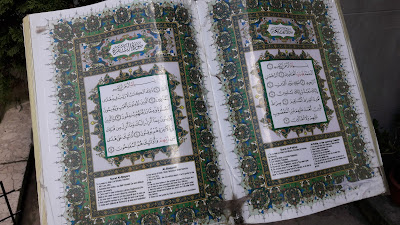The Black Sea is a body of water between
Eastern/Southeastern Europe and Western Asia, bounded by Bulgaria, Georgia,
Romania, Russia, Turkey, and Ukraine. It is supplied by a number of major
rivers, such as the Danube, Dnieper, Rioni, Southern Bug, and Dniester. The
Black Sea has an area of 436,400 km2 (168,500 sq mi) (not including the Sea of
Azov), a maximum depth of 2,212 m (7,257 ft), and a volume of 547,000 km3
(131,000 cu mi). It is constrained by the Pontic Mountains to the south and by
the Caucasus Mountains to the east, and features a wide shelf to the northwest.
The longest east-west extent is about 1,175 km (730 mi).
The Black Sea has a
positive water balance; that is, a net outflow of water 300 km3 (72 cu mi) per
year through the Bosphorus and the Dardanelles into the Aegean Sea.
Mediterranean water flows into the Black Sea as part of a two-way hydrological
exchange. The Black Sea outflow is cooler and less saline, and floats over the
warm, more saline Mediterranean inflow – as a result of differences in density
caused by differences in salinity – leading to a significant anoxic layer well
below the surface waters. The Black Sea drains into the Mediterranean Sea and
then the Atlantic Ocean, via the Aegean Sea and various straits. The Bosphorus
Strait connects it to the Sea of Marmara, and the Strait of the Dardanelles
connects that sea to the Aegean Sea region of the Mediterranean. These waters
separate Eastern Europe and Western Asia. The Black Sea is also connected to
the Sea of Azov by the Strait of Kerch.
----------------------------------
Constanța (Romanian pronunciation: [konˈstant͡sa] (
listen)), historically known as Tomis (Greek: Κωνστάντζα or Κωνστάντια,
Konstantia, Bulgarian: Кюстенджа or Констанца, Turkish: Köstence), is the
oldest continuously inhabited city in Romania. It was founded around 600 BC.
The city is located in the Dobruja region of Romania, on the Black Sea coast.
It is the capital of Constanța County and the largest city in the region. According
to Jordanes (after Cassiodorus), the foundation of the city was ascribed to
Tomyris the queen of the Massagetae (The origin and deeds of the Goths): "After
achieving this victory (against Cyrus the Great) and winning so much booty from
her enemies, Queen Tomyris crossed over into that part of Moesia which is now
called Lesser Scythia - a name borrowed from Great Scythia -, and built on the
Moesian shore of the Black Sea the city of Tomi, named after herself."
In 29 BC the Romans captured the region from the Odryses,
and annexed it as far as the Danube, under the name of Limes Scythicus
("Scythian Frontier"). In AD 8, the Roman poet Ovid (43 BC-17) was
banished here by Augustus and it was where he spent the remaining eight years
of his life. He laments his exile in Tomis in his poems: Tristia and Epistulae
ex Ponto. Tomis was "by his account a town located in a war-stricken
cultural wasteland on the remotest margins of the empire".

























































Niciun comentariu:
Trimiteți un comentariu